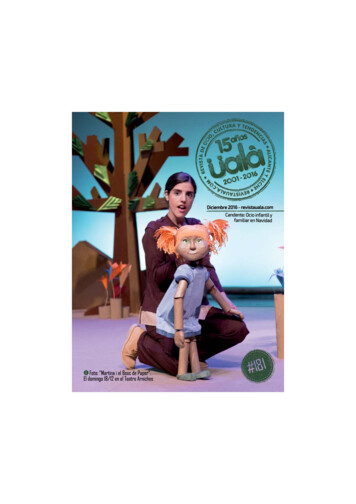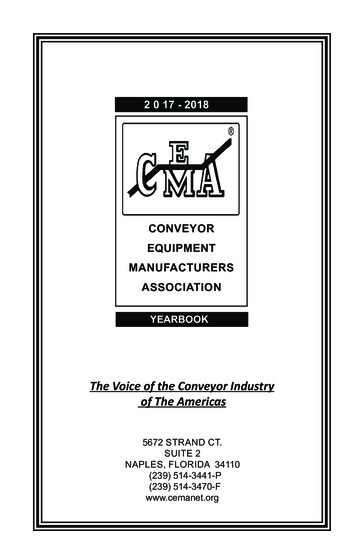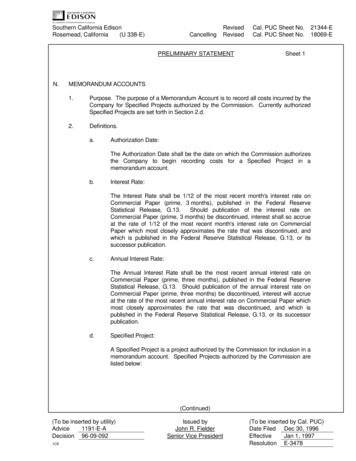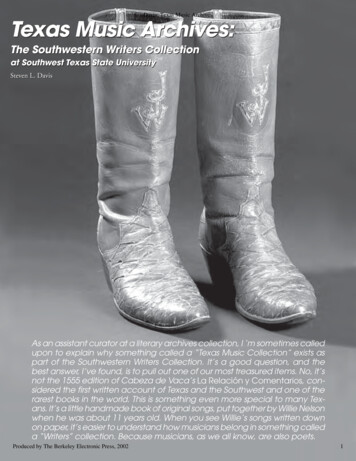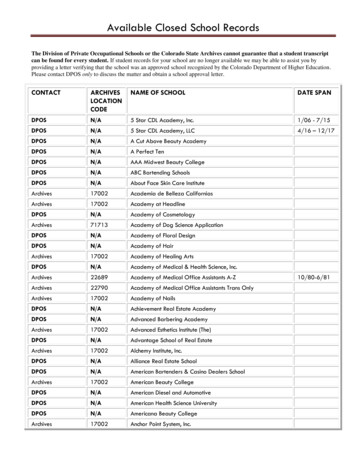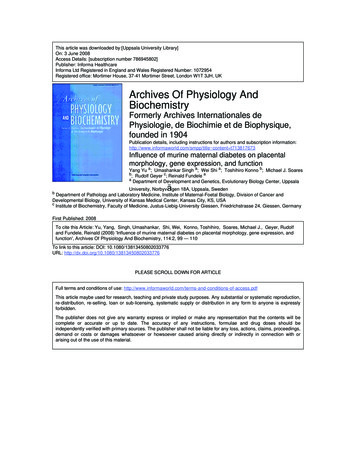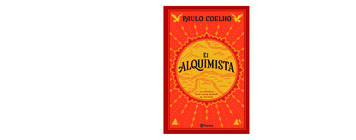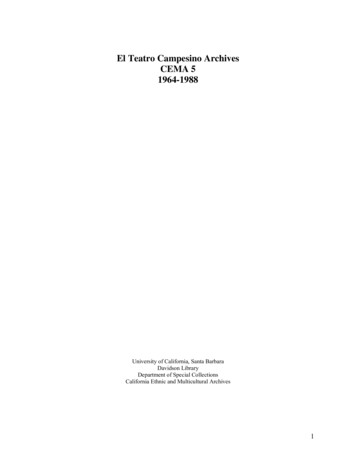
Transcription
El Teatro Campesino ArchivesCEMA 51964-1988University of California, Santa BarbaraDavidson LibraryDepartment of Special CollectionsCalifornia Ethnic and Multicultural Archives1
Summary InformationCollection: El Teatro Campesino ArchivesCollection Number: CEMA 5Size Collection: 284.5 linear feet (142 boxes, 118 videotapes, 46 albums, and 114 posters).Acquisition Information: Donated by El Teatro Campesino, 1986.Access restrictions: noneUse Restriction: Copyright has not been assigned to the Department of Special Collections,UCSB. All requests for permission to publish or quote from manuscripts must be submitted inwriting to the Head of Special Collections. Permission for publication has not been given to theDepartment of Special Collections as the owner of the physical items. Permission of thecopyright holder, must be obtained.Processing Information: Salvador Guerena, Rosemarie Leon and California Ethnic andMulticultural Archives staffLocation: Del Norte. (Series 4, boxes 1-2 and series 5, boxes 1-13, and series 9, box 1 are storedin the Southern Region Library Facility)Provenance: Donated by El Teatro Campesino, 1986Restrictions: Donor permission required to accessPublication Rights: Copyright resides with donorComments: Major funding from the Ford Foundation. Guide was produced with support fromthe University of California Institute for Mexico and the United States (UC MEXUS).Project Archivist: Salvador GüereñaPrincipal Processors: Rosemarie Leon, Andres GutierrezProcessors: Enedina Galarza, Romelia Salinas, Joseph VelascoGuide Prepared by: Meg MorrisDate: processing completed May 15, 19882
Organizational HistoryThe Teat ro Cam pesino Archi ves represents over t wenty years of th is th eater co mpany's activ ities, th e co untry’snewsest i nfluential Lat ino t heater gr oup a nd o ne which h as made m ajor con tributions to Ch icano cu lture i n th eUnited States and to the development and expansion of the boundaries of theater everywhere.El Teat ro C ampesino be gan with s hort p erformances i n t he fields of California's centr al valley for audienc es offarmworkers in 1965. By 1970 the Teatro had gained an international reputation and had inspired the formation ofmany ot her C hicano t heater com panies. T he t ransformation st arted i n a cont ext of a new a wareness of c ulturalidentities in the 1 960s wh ich broug ht a new con sciousness of t heir social, p olitical, an d econ omic p ositions tominorities. This context provided one of the resources which contributed to El Teatro's growth: audiences who wereready for th e clarity wh ich i ts d ramatic art b rought to thei r situ ation. The performances drew on trad itions fromEuropean drama such as c ommedia de ll'arte, Spanis h religious dramas ad apted for teaching Missi on Indians, aMexican t radition o f per formances i n C alifornia whi ch b egan i n t he m id-ninteenth ce ntury, and Aztec and M ayasacred r itual dramas. Th e name g iven to tr aveling groups of Aztec act ors, tlaquetzque, "those wh o mad e thingsstand out,"seems particularly apt for the performances of El Teatro Campesino.The events of the times were made to stand out beginning in 1965 by Luis Valdez, a Chicano who was o ne of tenchildren of farmworkers who followed the crops for a living. Luis Valdez worked in the fields with his family fromthe age o f si x, an d at tended schools i n t he San Joa quin Valley. An early in terest in drama was exp ressed i n thepuppet shows he gave for neighbors and friends. He finished high school and went to San Jose State College, wherehe received a B.A. in 1964 i n math and E nglish. T he drama department of San Jose State University produced hisfirst ful l-length pl ay. He wo rked wi th t he San F rancisco M ime Troupe f or seve ral months, t hen went t o hi sbirthplace, Del ano, where he joine d Cesar Chavez, leader of the striking United Farm workers of America, andformed El Teatro Cam pesino. Valdez's influe nce on t he theater world includes teac hing drama at Fres no StateCollege from 1968 to 1970 and at the University of C alifornia at Berkeley and Santa Cruz from 1971 to 1974. Hehas continued heading workshops at the Teatro's San Juan Bautista headquarters. Valdez was appointed to advisoryboards of th e International Theater Institute in New Yo rk and PBS's Visions Project at KCET in Los Angeles. Hehas serv ed on the th eater p anel for th e National Endowment fo r th e Arts and in o ther theater adv isory cap acities.Throughout i ts hi story, fr om t he earl y days of pe rforming o n fl atbed t rucks t o t he fu lly devel oped pr ofessionalproduction of "Zoot Suit" on Bro adway, Valdez has been the inspiration and guide for th e collective efforts of th eTeatro.In t he early years, all of the actors were farm worke rs. Valdez em phasized ensem ble work, in which all actorscontributed to the interpretation of th e performance. Most troupe members took on multiple roles. One person, forexample was a n actor, techni cal director, company manager, and t our coordinator; another was an a ctor, businessmanager, a dministrative director, resea rcher, a nd producer. Mem bers of the Teatro created t heir own m aterial.They started with no scenery, no scripts, and no costumes. They used props and costumes casually, and hung signsaround their necks t o i ndicate cha racters. Work ing with th eir o wn material, the actors we re free to express whatthey knew and felt. "Real theater lies in the excited laughter (or silence) of recognition in the audience, not in all theparaphernalia on the stage," said Valdez. The dramas were short, but Valdez decided to call them actos rather thanskits, because skits seemed too light a wo rd to express the work they were doing. In 1967 Valdez explained that ElTeatro's purpose was to e xamine and re define the heart of the Chicano people: ritual, music, beauty, and spiritualsensitivity. He sees th eater as a vehicle "to affect and modify and change and give direction to society. . . You cantake peo ple's m inds of f t heir pr oblems by ent ertaining t hem, but y ou can al so d o t hat by gi ving t hem a di fferentperspective," said Valdez in a later in terview. "One of my approaches to life in general [is] if you feel you're shortchanged, fill the gap yourself. Why mope? Why feel angry? You've got the power to do something."Humor has always bee n a n important ingredient i n the T eatro's drama, i nspired by Mexican folk humor whi ch i stypified by t he perform ances of the Me xican c omedian Cantinflas. Valdez e xplains that t he troupe was notconcerned with being witty, but only with the truth of the moment, and humor was found in raw truth. Social pointswere made not in spite of comedy, but through it, using broad farcical statements. Humor became a major asset andweapon, adding understanding and appeal to the messages of the actos.3
Chicanos wh o saw th e po pular su ccess of El Teatro Camp esino in th e sev enties felt that it h ad b rought Ch icanophilosophy not only to new audiences, but to the artistic hear t of the system. "I want audiences to get up off theirseats and go out of the t heater feeling so mewhat better ab out life. . . I want them to sense human unity rather thandivisiveness," said Valdez after "Zoot Suit" opened on Broadway.Awards honoring El Teatro Campesino and/or the work of Luis Valdez i nclude: the Ob ie Award in 1968, the LosAngeles Drama Critics Award in 1969 and 1972, 11 Bay Area critics award s for " Corridos" in 1983, Peab odyAward for "Corridos" in 1987, an Emmy for "Los Vendidos" in 1972, and the Los Angeles Critics Circle Award andeight Drama-Logue Awards for "Zoot Suit" in 1978.The following ti meline p resents so me o f the highlights of El Teatro Cam pesino reflecting th e history of t heorganization up to the date that the archives were established.1965- Valdez founded El Te atro C ampesino, w hich was the cultural and prop agandistic ar m o f th e United FarmWorkers of America for two years . El Te atro went on i ts first national to ur to raise fu nds for t he strikin g farmworkers.1967- El Centro Campesino Cultural was established and the dramas addressed broader themes related to Chicanoculture, including: education, Vietnam, indigenous roots, and racism.1969- The Teatro participated in a world theater festival in France, moved its headquarters to Fresno, produced thefilm " I am Joaquin," which won se veral a wards, an d c reated El Teatro Nacional de Aztlan (TE NAZ), a nat ionalnetwork of Chicano theater groups:1969 to '80- The Teatro toured across the United States and Mexico and made six tours to Europe.1971- El Teatro Campesino moved its h eadquarters to San Juan Bautista. Trad itional religious plays, "La Virgendel Tepeyac" and "La Pastorela" were adapted for Christmas celebrations at the center. Valdez was appointed to theadvisory boards o f t he In ternational Th eater In stitute in New York and to PBS Visions project in Lo s Angeles.Valdez taught drama at the University of California in Berkeley and Santa Cruz from 1971 to1974.1973-British th eater d irector Peter Bro ok an d his Paris-base d co mpany p articipated in an exp erimental wo rkshopwith El Teatro Campesino in San Juan Bautista. "La Carpa de los Rasquachis" played at the Brooklyn Academy ofMusic.1975- "El Fin del Mundo" and the puppet play "La Pastorela"were produced at San Juan Bautista.1976- The U .S. St ate Department, as pa rt of i ts B icentennial p rogramming, de signated t he E uropean t our of " LaCarpa" as an official event. "La Carpa" was also filmed for PBS under the title "El Corrido."1977- Th e Teatro co mpany appeared in the f ilm "Which Way Is Up?" and Valdez collaborated on the scree nplay."La Pastorela" became a play for actors.1978- "Zoot Suit," written and directed by Valdez, was presented at the Aquarius Theater, Los Angeles, and went toBroadway for four weeks in 1979.1981- T he Tea tro o pened i ts playhouse, co nverted fr om a fruit-packing s hed i n San J uan B autista, a nd presentedValdez's adaptation of David Belasco's "The Rose of the Rancho," and Valdez's play, "Bandido," based on a figure inCalifornia history.1982-"Corridos," a new form using mime, music, and theater to explore the lives of the campesino, was produced atthe playhouse .1983-"Corridos" played at Marines Mem orial Theater in San Fra ncisco, Old Globe Theater in San D iego, and theVariety Arts Theater in Los Angeles. The film version of "Zoot Suit," directed by Valdez, opened the London FilmFestival.4
1984- "Corridos" was presented on PBS station KQED, San Francisco.1985--Two El Teatro Campesino plays were a part of the Public Theater's Festival Latino in New York.1986- " I Don't Have to Show You No Stinking Badges," a play by Valde z, premiered at the Los Angeles TheaterCenter and played for four months.1987- Valdez directed the film "La Bamba." In San Juan Bautista the members continued the work of the Teatro asa professional company and a cultural institution. It reach ed out to new American audiences while preserving anancient tradition of popular classics and introducing new original work by Latinos and Latinas.Scope NoteThe archives of El Teatro Ca mpesino are the largest archival colle ction on Chic ano theater, c onsisting ofapproximately 15 7 l inear fe et of arc hives and m anuscripts. They i nclude a variety of formats, dat ing f rom t heTeatro's founding in 1965. Th ey include primary materials for researchers with an interest in t heater arts, culturalarts, h istory, political scien ce, lab or relations, ethn ic stu dies, so ciology, antropology, an d women's st udies. Mo stmaterials are in English; some are in Spanish or a combination of the two languages. At least eight other languagesare represented, an indication of the international interest in the Teatro.The archives document important biographical facts and evolutionary processes which involved the playwright anddirector Luis Valdez, the many players in the theater company, and unique information concerning many importantcultural, po litical, literary, an d artistic in dividuals with w hom El Teatro Ca mpesino has in teracted ov er t he yearssince its founding in 1965. All the phases of the Teatro's development are represented from the farm workers' strikeyears in 1965 through 1967; establishment of the San Juan Bautista center as the base for growth and developmentof new t hemes an d t he point o d departure f or t ours from 197 1 t o t he present; co mmercial t heater an d filmproductions from 1977 to 1988.Since El Teatro Cam pesino is a vital an d activ e org anization, it will con tinuously g enerate n ew records th at willeventually be transferred to the archives at UCSB.The Teatro archives are divided into the seventeen series decscribed below.Series DescriptionsSeries I: Scripts, ca. 1967-1986. Series I consists of 152 manuscripts of plays and is housed in thirty-nine archivalboxes. This is the research core of the collection, containing final and working copies, published and unpublishedscripts of plays. Some include accompanying notes and/or songsheets. Scripts from the early period include theactos given by farmworkers on flatbed trucks. Later productions include plays given at the playhouse in San JuanBautista, and scripts for both the play and screenplay of "Zoot Suit." All versions of the same play are groupedtogether, so it is possible to see the evolution of one play over time. Following are a few examples of outstandingproductions that have scripts in Series 1: "La Gran Carpa de los Rasquachis" ("T he Great Tent of t he Underdogs") was t he first collective fulllength play. T he Teatro included it in a Eu ropean tour in 1976 and it was d esignated an official eve nt forthe U.S. Bicentennial. It was also filmed for PBS under the title "El Corrido." The play "Zoot Suit," according to Jorge Huerta, "combined elements of the acto, corrido, carpa, and mitowith Living Newspaper teachniques to dramatize a Ch icano family in crisis." Th is was the first Ch icanoplay to enjoy a long commercial success. "The Shrunken Head of Pancho Villa" was the first full-length play th at Luis Val dez wro te. It wasproduced at San Jose State University in 1964. "Soldado Razo" sho ws th e acto in t ransition. Whereas early actos used no p rops, sets, o r costumes,"Soldado" requires some furniture. Valdez said "Dark Root of a Scream" is a mito, a si tuation seen through the eyes of God, in contrast withthe acto, which was seen through the eyes of man. First produced in the early seventies, "Dark Root" wasrevived in a 1985 version.5
"I Don't Got to Show You No Stinking Badges" received its title from a scene in t he motion picutre "TheTreasure of Si erra Ma dre." The play is about a m aterially su ccessful Ch icano family o f th e eighties .Themes, also used else where by Valdez, are of a family in crisis and the search for identity of each of thefamily members. One reviewer tells us that the play deals with universal themes, and is topical, access ibleand funny.Other major plays include “La Virgen del Tepeyac,” “La Pastorela,” “Bandido,” “Bernabe,” “Soldierboy,”and “The Fabulous Life and Death of Don Juan Terrovio.”Series II: Published Books, Journals and Magazines, 1967-1986. This series consists of two subseries of one boxeach housed in the Special Collections, and one box of unprocessed miscellaneous periodicals in the Library Annex.SubseriesIIA comprises si xty-five journals an d m agazines dat ed f rom 196 7 t o 1988. These periodicalscontain interviews, reviews of Teatro plays and movies and background articles , some of which comment on artisticand political aspects. Som e pieces give biographical information about Valdez and other El Teat ro Cam pesinomembers. There are reviews of plays and of books that include mention of the Teatro. Periodicals in this series areas diverse as California Theatre Annual, Time, and various university publications, and represent more than half adozen countries.SubseriesIIB consists o f sixty books d ated from 19 70 t o 19 86. The books c ontain c hapters, essay s, orsections about El Teatro Campesino or Chicano theater. Subject matter is similar to that in the journals in SubseriesIIA. Exam ples of books included are Theater Past and Present, Chicana Voices, and Guerilla Theater. Engl ish,Spanish, and other languages are represented. Also in this subseries are one set of conference proceedings, and oneessay from a book written in Polish.Series III: Published Reviews, Articles, Interviews 1964-1987. Series III consists of 316 published pieces aboutthe Teatro from magazines and newspapers, housed in 53 archival boxes. These articles were cut from magazinesand newspapers included in the original El Teatro Campesino files. They are chronologically filed in folders. Somearticles are by Luis Valdez. Others, by various authors, are about Teatro plays, performances, and the connectionwith farmworkers. Some articles report about Chicanos on stage and in film, the making of films with which Valdezwas involved, and the archival collection of El Teatro Chicano at UCSB. There are interviews with Luis Valdezand reviews of plays and films. Many are from California publications; some are from various locations where theTeatro toured.Series IV: Film Edited and Unedited. The films were transferred to video and are described in Series V, below.Series V: Video, Edited and Unedited 1974-1988. The 118 videos, available on DVDs and Online, containfilms of El Teatro Campesino plays, television specials, concerts, interviews, news footage, commercials, andworkshops. This series includes the first known film that has a segment about the Teatro, "Huelga," narrated by CesarChavez. Other films range from the early actos to television specials on the movie "Zoot Suit." There are films ofscenes from plays and whole plays, interviews with Valdez and others, footage of the twentieth anniversary gala ofEl Teatro Campesino, and a documentary on the history of the Teatro made in 1981. They originate in severallocations, including Monterey, Sacramento, San Jose, and various parts of Mexico.Series VI: Photographs, 1966-1987. Series VI comprises 3,417 individual photographs housed in thirty-nine boxes.The 257 listings in the guide give the years and a general description of the subjects in each file folder. Theyillustrate productions, cast members, local and tour locations, events, and history of El Teatro Campesino. Filmstrips, small candid snapshots, and 8x10 photographs, black and white and in color, are all in this collection. Manyinformal pictures show the Teatro members and their families at leisure. Other photos are of rehearsals,performances, and audiences. There are many publicity stills of various actors and musicians.Series VII: Photo Negatives. These are negatives of the photographs in Series VI, kept in three albums. One boxof unprocessed negatives is in the Library Annex.Series VIII: Slides 1967-1986. Twenty-three albums house the slides. The guide provides 253 listings of multipleitems in ten subseries. A few examples in each of the subseries are given in the following description:(1) Posters-- includes many huelga posters, most in color; (2) Productions-- European and local performances; (3)Conferences, Workshops, and Symposia; (4) Events-- Some examples are: celebrations at San Juan Bautista, thefirst TENAZ festival,world premeire of the motion picture "Zoot Suit" (5) Art Works and Exhibitions-- Includes6
typical Mexican costumes, George Ballis photography exhibit; (6) Research and Reference Materials-- for example:references for "I Am Joaquin," poem, play, and motion picture, San Juan Bautista Mission, slides of pre-Columbianart, (7) Masks; (8) Costumes; (9) Props; and (10) Miscellaneous--portraits, candid shots of members and families,outdoor scenery.Series IX: Audio Recordings 1966- 1986. Series IX consists of 385 items in nine subseries, housed in twenty-threealbums in the Special Collections. One carton of unprocessed audio cassette albums is in the Library Annex.(1) Luis Valdez (Interviews, Speeches, Lectures, Seminars, etc.) Th is su bseries in cludes in terviews with C ubanworkers and a Fidel Castro rally; (2) Teatro Members (Interviews, etc.); (3) Conferences, Workshops, Discussions-includes fi rst meeting of TENAZ.; (4 ) Misc. Music and Sound Effects--used i n performances; (5 ) Corridos-Traditional Mexican ballads and also specific music, audition tapes, and advertising for the production of Corridos;(6) Zoot Suit (Resource Music, Sound Effects, Research, and Notes--for b oth pla y and m otion picture; (7)Performances (Performance Music and Sound Effects)--for m any other pr oductions; (8 ) Miscellaneous--includesdemonstration t apes, co rrespondence, rea dings ab out C hicanos, a nd a bi rthday par ty for Val dez. (9) Huelga(Interviews, Speeches, Meetings, Music)--includes church services, rallies, and weekend camps;Series X: Historical Masks, Costumes, Props . These remain at ETC headquarters.Series XI: Lighting Plots, Costume Renderings, Set and Prop Designs, ca. 1974-1985. These 385 large scaleitems are housed at the UCSB Library Annex in fifteen cartons. They include plans of the San Juan BautistaPlayhouse, designs for various productions there; production designs for Corridos at Marines Memorial Theater inSan Francisco and at other locations; ground plans and film shoot sequences for the motion picture Zoot Suit. Fifteencartons of designs remain unprocessed.Series XII: Press Files, Releases, PSA's Original Art/Graphic Work, Layouts, Advertising Photo Transferes,Pertinent Correspondence. These remain at ETC headquarters.Series XIII:Poster Collection, ca. 1967-1984. This series consists of 121 posters in six portfolio cartons, three rollcontainers of oversize posters from the European tour, and two duplicate slide sets. These are housed in the UCSBLibrary Annex. El Teatro Campesino's history can be traced through the poster collection, beginning with postersfor the first performances and continuing through plays and performances in national and European locations. Theseposters are duplicated in the slides in Series VIII.Series XIV: Supplemental Printed Matter: Programs, Flyers, Brochures, Playbills, etc., 1965-1989. Nineteenboxes house the 549 items which are chronologically arranged. Mailers, buttons, and advertisements are also foundin this series. The original flyer which established El Teatro Campesino is here, with other early flyers announcingactos. Other flyers announce performances throughout the Teatro's history during the twenty-five years included.Series XV: Organizational Papers: Accounting Files, Legal Documents, Articles of Incorporation, By-Laws,Mission Statements, Pertinent Correspondence. Documents about operations, product sales, and otheradministrative files totaling eight and one-half linear feet are in the University Library Annex.Series XVI: Awards and Honors (Teatro and Valdez Collections). These 105 items arranged chronologicallywill remain at El Teatro Campesino headquarters.Series XVII: Unpublished Scholarly Works (including dissertations and theses), 1967-1987. The seven boxesof this series contain twenty items. These include works authored by Jorge Huerta, Betty Diamond, Luis Valdez,and others. They originated at several universities, and include transcripts of lectures given by Valdez at theUniversity of California at Irvine in 1984.7
Table Of ContentsSeries I: Scripts, ca. 1967-1986. . 8Series IIA: Published Books, Journals and Magazines, 1967-1986. . 17Series IIB: Published Books, Journals and Magazines, 1967-1986. 22Series III: Published Reviews, Articles, Interviews 1964-1987. . 26Series V: Video, Edited and Unedited 1974-1988. 63Series VI: Photographs, 1966-1987. . 76Series VII: Photo Negatives. 100Series VIII: Slides 1967-1986. 100Series IX: Audio Recordings 1966- 1986. 124Series X: Historical Masks, Costumes, Props . 163Series XI: Lighting Plots, Costume Renderings, Set and Prop Designs, ca. 1974-1985. . 163Series XIV: Supplemental Printed Matter: Programs, Flyers, Brochures, Playbills, etc., 19651989. 200Series I: Scripts, ca. 1967-1986.1. Huerta, Jorge. Introduction to the Shrunken Head of Pancho Villa [Introduction]. n.p.: El Teatro de laEsperanza; n.d.;9p.Call Number: Series 1. Box 1 Folder 1 Play Number 1.0012. Valdez, Luis. The Shrunken Head of Pancho Villa [Script]. San Juan Bautista, Calif.: El Teatro Campesino;[1967];67p.Call Number: Series 1. Box 1 Folder 2 Play Number 1.0023. The Shrunken Head of Pancho Villa [Script]. San Juan Bautista, Calif.: El Teatro Campesino; 1967;72p.Call Number: Series 1. Box 1 Folder 3 Play Number 1.0034. The Shrunken Head of Pancho Villa [Script]. San Juan Bautista, Calif.: Cucaracha Publications, El TeatroCampesino; 1974;153p.Call Number: Series 1. Box 1 Folder 4 Play Number 1.0045. The Shrunken Head of Pancho Villa [Script]. San Juan Bautista, Calif.: El Teatro Campesino; n.d.;39p.Call Number: Series 1. Box 2 Folder 1 Play Number 1.0056. The Shrunken Head of Pancho Villa [Script]. San Juan Bautista, Calif.: El Teatro Campesino; n.d.;38p.Call Number: Series 1. Box 2 Folder 2 Play Number 1.0067.Dos Vatos [Notes and Concepts]. San Juan Bautista, Calif.: El Teatro Campesino; n.d.;52p.Call Number: Series 1. Box 3 Folder 1 Play Number 2.0018
8. Palomino, Ernesto. Dos Vatos [Scenario]. Fresno, Calif.: n.p.; 1970;5p.Call Number: Series 1. Box 3 Folder 2 Play Number 2.0029.Dos Vatos [Script]. [Fresno, Calif.]: El Teatro Campesino; [1970];6p.Call Number: Series 1. Box 3 Folder 3 Play Number 2.00310 . Palomino, Ernesto and Ricardo Duran. Dos Vatos [Script with audio and video transcript]. [Fresno, Calif.]:El Teatro Campesino; [1970];8p.Call Number: Series 1. Box 3 Folder 4 Play Number 2.00411. El Soldado Razo [Script]. Original ed. San Juan Bautista, Calif.: El Teatro Campesino; 1971 Mar 24;14p.Call Number: Series 1. Box 4 Folder 1 Play Number 3.00112. El Soldado Razo [Script]. San Juan Bautista, Calif.: El Teatro Campesino; n.d.;13p.Call Number: Series 1. Box 4 Folder 2 Play Number 3.00213. El Soldado Razo [Script]. San Juan Bautista, Calif.: El Teatro Campesino; n.d.;12p.Call Number: Series 1. Box 4 Folder 3 Play Number 3.00314. El Soldado Razo [Script]. Restaged version ed. San Juan Bautista, Calif.: El Teatro Campesino; 1985;27p.Call Number: Series 1. Box 4 Folder 4 Play Number 3.00415. El Mero Christmas de Juanito Raza [Script]. San Juan Bautista, Calif.: El Teatro Campesino; 1971 Dec10;13p.Call Number: Series 1. Box 5 Folder 1 Play Number 4.00116. El Mero Christmas de Juanito Raza [Script]. San Juan Bautista, Calif.: El Teatro Campesino; 1971 Dec10;15p.Call Number: Series 1. Box 5 Folder 2 Play Number 4.0021 7. Juanito [Script]. San Juan Bautista, Calif.: El Teatro Campesino; n.d.;11p.Call Number: Series 1. Box 5 Folder 3 Play Number 4.00318. Juanito: A Puppet Show [Script]. San Juan Bautista, Calif.: El Teatro Campesino; n.d.;11p.Call Number: Series 1. Box 5 Folder 4 Play Number 4.00419.El Patron [Scenario]. San Juan Bautista, Calif.: El Teatro Campesino; n.d.;4p.Call Number: Series 1. Box 6 Folder 1 Play Number 5.00120. La Conquista de Mexico: A Puppet Show [Script]. San Juan Bautista, Calif.: El Teatro Campesino; n.d.;26p.Call Number: Series 1. Box 6 Folder 2 Play Number 6.00121. La Conquista de Mexico: A Puppet Show [Script]. San Juan Bautista, Calif.: El Teatro Campesino; n.d.;8p.Call Number: Series 1. Box 6 Folder 3 Play Number 6.00222. La Conquista de Mexico [Script]. Spanish version ed. San Juan Bautista, Calif.: El Teatro Campesino;n.d.;10p.Call Number: Series 1. Box 6 Folder 4 Play Number 6.00323. La Conquista del Pedro Minetti o Don Socato en el Boycoteo [Scenario]. San Juan Bautista, Calif.: El TeatroCampesino; n.d.;4p.Call Number: Series 1. Box 7 Folder 1 Play Number 7.00124. La Conquista del Pedro Minetti o Don Socato en el Boycoteo [Scenario]. San Juan Bautista, Calif.: El TeatroCampesino; n.d.;3p.9
Call Number: Series 1. Box 7 Folder 2Play Number 7.00225. La Lucha de un Pueblo [Scenario]. San Juan Bautista, Calif.: El Teatro Campesino; n.d.;2p.Call Number: Series 1. Box 7 Folder 3 Play Number 8.00126. La Quinta Temporada [Script]. English version ed. San Juan Bautista, Calif.: El Teatro Campesino; n.d.;27p.Call Number: Series 1. Box 7 Folder 4 Play Number 9.00127. La Quinta Temporada [Script]. Spanish version ed. San Juan Bautista, Calif.: El Teatro Campesino; n.d.;17p.Call Number: Series 1. Box 7 Folder 5 Play Number 9.00228. La Quinta Temporada (La Cinquieme Saison) [Script]. French version ed. Nancy, France: Festival MondialDu Theatre; April 19-27 ?;9p.Call Number: Series 1. Box 7 Folder 6 Play Number 9.00329. Las Dos Caras del Patroncito [Script]. [Delano, Calif.]: El Teatro Campesino; [1965];11p.Call Number: Series 1. Box 8 Folder 1 Play Number 10.00130. Las Dos Caras del Patron [Script]. Mexico, D.F.: n.p.; 1973;11p.Call Number: Series 1. Box 8 Folder 2 Play Number 10.00231.La Suegra [Script]. Original ed. San Juan Bautista, Calif.: El Teatro Campesino; n.d.;13p.Call Number: Series 1. Box 8 Fo
puppet shows he gave for neighbors and friends. He finished high school and went to San Jose State College, where he received a B.A. in 1964 in math and English. The drama department of San Jose State University produced his first full-length play. He wo rked with the San F
